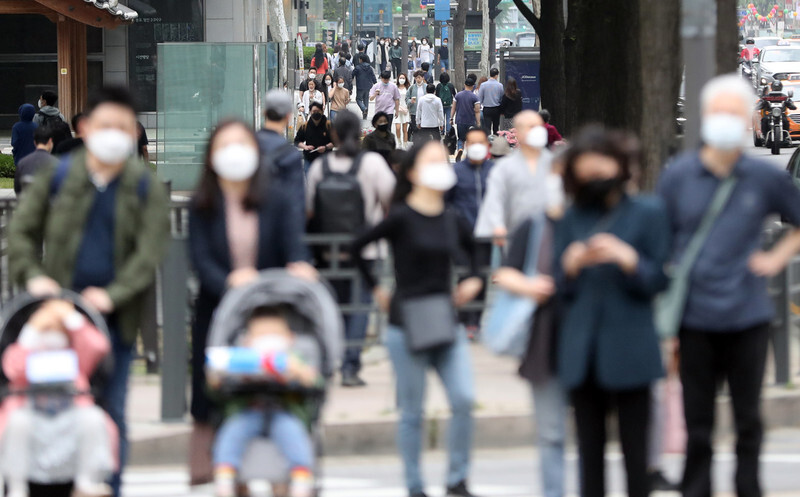hankyoreh
Links to other country sites 다른 나라 사이트 링크
S. Korea transitions to more relaxed social distancing measures, resuming economic activity

South Korea is transitioning to a more relaxed form of social distancing on May 6, which will likely lead to a resumption of the economic activities and daily routines frozen by the coronavirus. While the government is pondering whether to lower its infectious disease alert by one step from the current level of “red,” it’s also asking the public to abide by the rules of “everyday disease prevention,” while reminding them that intense social distancing could be reinstated at any time if the situation worsens.
The Korean Centers for Disease Control and Prevention (KCDC) reported that three more people had tested positive for COVID-19 on May 4 —the lowest number in 77 days, since two new cases were reported on Feb. 18. All three of the new cases were imported from overseas, which appears to be a positive sign as the country eases into everyday life quarantine.
While there was an average of a hundred new cases each day in mid-March, social distancing reduced the daily caseload to 9.1 people by late April. But concerns remain about the “silent” spread of the disease. In the last two weeks (Apr. 20-May 3), there have been eight cases (including five in Daegu and North Gyeongsang Province) in which the route of transmission is unclear. The authorities are also waiting to see the potential impact of a string of holidays between Apr. 30 and May 5, when many Koreans were out and about.
“Transitioning to everyday disease prevention doesn’t mean a return to life before COVID-19. Moving forward, each and every one of you, and our society as a whole, must take ownership and responsibility for preventing the spread of the disease,” said KCDC Deputy Director Kwon Jun-wook.
Government considers lowering alert level from red to orange
The government is still weighing the option of whether to lower the infectious disease alert from the highest level of “red,” meaning severe, to “orange,” a step down. “After soliciting the opinions of experts, the KCDC’s crisis assessment panel will convene to review that option,” said Kim Gang-lip, first general coordinator for Korea’s Central Disaster and Safety Countermeasures Headquarters, during the daily briefing on Tuesday.
A “red” alert is announced when the authorities believe that community-based transmission of the virus is occurring or that the virus has spread nationwide. The government issued the red alert on Feb. 23, when there were close to 400 new cases every day. That was the second time such an alert had been issued, after the H1N1 pandemic in 2009. Even if the alert level is lowered, the government’s various disease control measures, including the mask rationing system, will be left in place.
May 5 also marked the 100th day since the establishment of a “central accident response headquarters” under the Ministry of Health and Welfare. The headquarters had been working with other government ministries and local governments to lay the foundation for disease control. South Korean President Moon Jae-in sent workers at the headquarters 700 lunchboxes containing fruit and rice cakes to encourage them.
“Thanks to you, Koreans are able to relax. [The recent improvement] is the result of your efforts and dedication over the past hundred days you’ve been working without even taking a break,” the president posted on social media.
The KCDC and the disaster safety headquarters have been holding two briefings every day since Jan. 29 (except for the day of the parliamentary elections, on Apr. 15) with the 200th briefing held on Tuesday afternoon. In an online survey of a thousand adults around the country, 79.3% of respondents said they pay attention to the briefings while 77.4% viewed them positively, regarding them as “useful.” The survey was carried out by a team of researchers led by Yu Myeong-sun, a professor at the Graduate School of Public Health at Seoul National University (SNU).
By Choi Ha-yan, staff reporters
Please direct comments or questions to [english@hani.co.kr]

Editorial・opinion
![[Column] Life on our Trisolaris [Column] Life on our Trisolaris](https://flexible.img.hani.co.kr/flexible/normal/500/300/imgdb/original/2024/0505/4817148682278544.jpg) [Column] Life on our Trisolaris
[Column] Life on our Trisolaris![[Editorial] Penalties for airing allegations against Korea’s first lady endanger free press [Editorial] Penalties for airing allegations against Korea’s first lady endanger free press](https://flexible.img.hani.co.kr/flexible/normal/500/300/imgdb/original/2024/0502/1817146398095106.jpg) [Editorial] Penalties for airing allegations against Korea’s first lady endanger free press
[Editorial] Penalties for airing allegations against Korea’s first lady endanger free press- [Editorial] Yoon must halt procurement of SM-3 interceptor missiles
- [Guest essay] Maybe Korea’s rapid population decline is an opportunity, not a crisis
- [Column] Can Yoon steer diplomacy with Russia, China back on track?
- [Column] Season 2 of special prosecutor probe may be coming to Korea soon
- [Column] Park Geun-hye déjà vu in Yoon Suk-yeol
- [Editorial] New weight of N. Korea’s nuclear threats makes dialogue all the more urgent
- [Guest essay] The real reason Korea’s new right wants to dub Rhee a founding father
- [Column] ‘Choson’: Is it time we start referring to N. Korea in its own terms?
Most viewed articles
- 160% of young Koreans see no need to have kids after marriage
- 2Presidential office warns of veto in response to opposition passing special counsel probe act
- 3New sex-ed guidelines forbid teaching about homosexuality
- 4Months and months of overdue wages are pushing migrant workers in Korea into debt
- 5OECD upgrades Korea’s growth forecast from 2.2% to 2.6%
- 6[Guest essay] Maybe Korea’s rapid population decline is an opportunity, not a crisis
- 7[Column] Life on our Trisolaris
- 8Another chaebol heir caught smuggling liquid marijuana into South Korea
- 9S. Korea discusses participation in defense development with AUKUS alliance
- 10Bills for Itaewon crush inquiry, special counsel probe into Marine’s death pass National Assembly